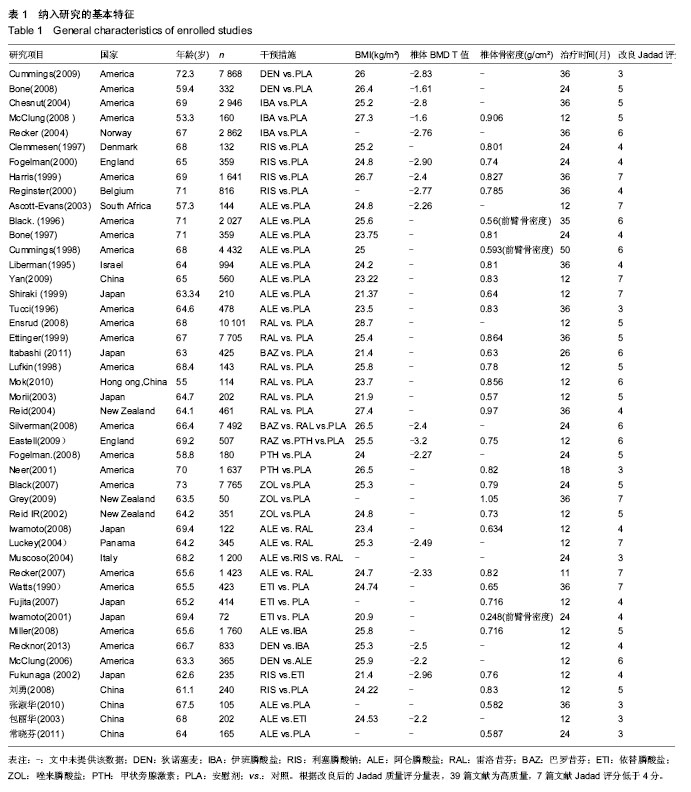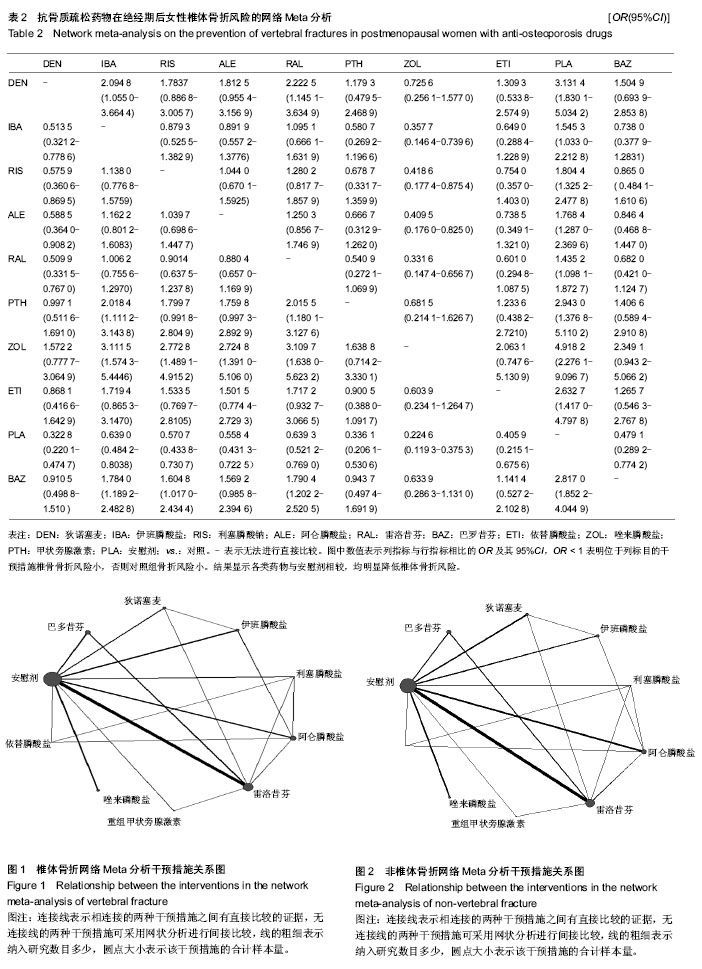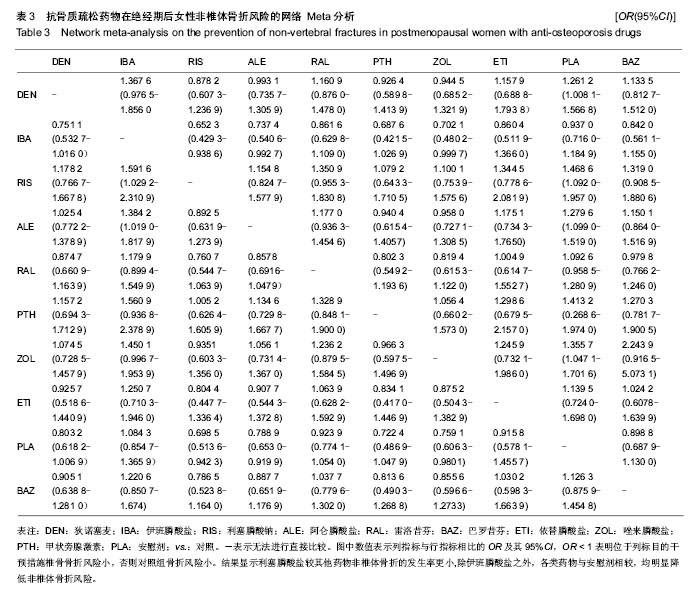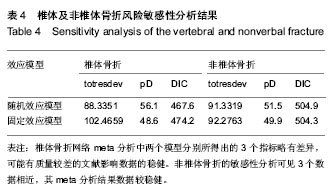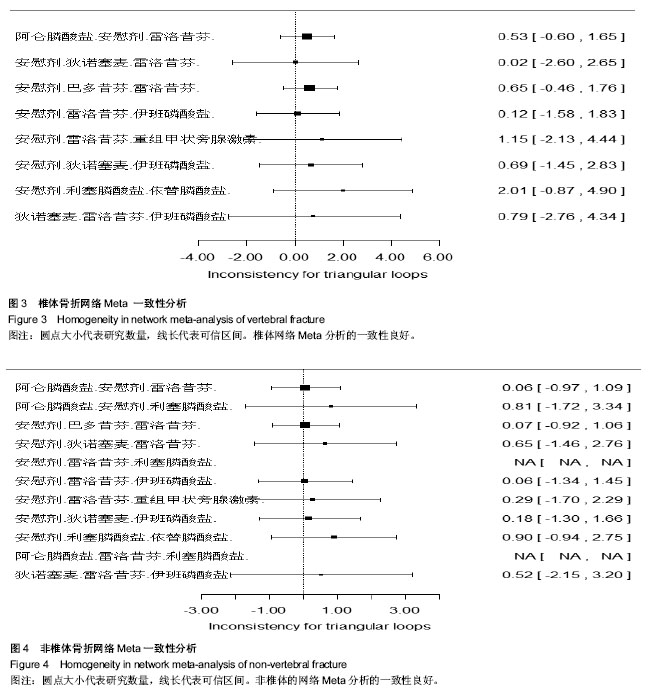| [1] 王思成,杨雪骅,苏佳灿,等.抗骨质疏松药物临床应用的进展[J].中国组织程研究与临床康复,2009,13(46):9163-9166.
[2] Jadad AR,Moore RA,Carroll D,et al.Assessing the quality of reports of randomized clinical trials:is blinding necessary. Control Trails.1996;17(1):1.
[3] Jansen JP,Crawford B,Bergman G,et al.Bayesian meta-analysis of multiple treatment comparisons: an introduction to mixed treatment comparisons.Value Health. 2008;11(5):956-964
[4] 张天嵩,钟文昭.实用循证医学方法学[M].长沙:2012:433-442.
[5] 董圣杰,冷卫东,田家祥,等.Meta分析系列之五:贝叶斯Meta分析与WinBUGS软件[J].中国循证心血管医学杂志,2012,4(5): 395-398.
[6] 罗杰,冷卫东.系统评价/Meta分析理论与实践[M].北京:2013: 495-506.
[7] 曾宪涛,张超,郭毅.R软件R2WinBUGS程序包在网状Meta分析中的应用[J].中国循证医学杂志,2013,13(9):1137-1144.
[8] 张超,徐畅,曾宪涛.网状Meta分析中网状关系图的绘制[J].中国循证医学杂志,2013,13(11):1382-1386.
[9] Cummings SR, Martin JS, McClung MR,et al.Denosumab for Prevention of Fractures in Postmenopausal Women with Osteoporosis.N Engl J Med.2009;361(8):756-765.
[10] Bone HG, Bolognese MA,Yuen CK, et al.Effects of Denosumab on Bone Mineral Density and Bone Turnover in Postmenopausal Women.Clin Endocrinol Metab.2008;93(6): 2149-2157.
[11] Chesnut IC,Skag A,Christiansen C,et al.Effects of oral ibandronate administered daily or intermittently on fracture risk in postmenopausal osteoporosis.Bone Miner Res.2004; 19:1241-1249.
[12] McClung MR, Bolognese MA, Sedarati F, et al. Efficacy and safety of monthly oral ibandronate in the prevention of postmenopausal bone loss.Bone.2009;44:418-422.
[13] Recker R,Stakkestad JA,Chesnut CH,Ⅲ, et al.Insufficiently dosed intravenous ibandronate iigections are associated with suboptimal antifracture efficacy in postmenopausal osteoporosis. Bone.34:890-899.
[14] Clemmesen B, Ravn P, Zegels B, et al. A 2-year phaseⅡ study with 1-year of follow-up of risedronate (NE-58095) in postmenopausal osteoporosis.Osteoporos Int.1997;7: 488-495.
[15] Fogelman I,Ribot C, Smith R, Ethgen D, et al. Risedronate reverses bone loss in postmenopausal women with low bone mass: results from a multinational, double-blind, placebo- controlled trial BMD-MN Study Groiqx.Clin Endocrinol Metab. 2000;85(5):1895-1900.
[16] Harris ST, Watts NB, Genant HK, et al. Effects of risedronate treatment on vertebral and nonvertebral fractures in women with postmenopausal osteoporosis: a randomized controlled trial. Vertebral Efficacy With Risedronate Therapy (VERT) Study Group. JAMA.1999;282(14):1344-1352.
[17] Reginster JY, Minne HW, Sorensen OH, et al. Randomized trial of the effects of risedronate on vertebral fractures in women with established Postmenopausal Osteoporosis. Osteoporos Int.2000;11:83-91.
[18] Ascott-Evans BH, Guanabens N, Kivinen S, et al.Alendronate prevents loss of bone density associated with discontinuation of hormone replacement therapy: a randomized controlled trial.Arch Intern Med.2003;163:789-794.
[19] Black DM, Cummings SR, Karpf DB, et al.Randomised trial of effect of alendronate on risk of fracture in women with existing vertebral fractures.Fracture Intervention Trial Research Group. Lancet.1996;348:1535-1541.
[20] Bone HG, Downs RW Jr, Tucci JR, et al.Dose-response relationships for alendronate treatment in osteoporotic elderly women.Alendronate Elderly Osteoporosis Study Centers.J Clin Endocrinol Metab.1997;82(1):265-274.
[21] Cummings SR, Black DM, Thompson DE, et al. Effect of alendronate on risk of fracture in women with low bone density but without vertebral fractures:results from the Fracture Intervention Trial. JAMA.1998;280:2077-2082.
[22] Liberman UA, Weiss SR, Broll J, et al .Effect of oral alendronate on bone mineral density and the incidence of fractures in postmenopausal osteoporosis. The Alendronate Phase Ⅲ Osteoporosis Treatment Study Group.N Engl J Med.1995;333(22):1437-1443.
[23] Yan Y,Wang W,Zhu H,et al.The efficacy and tolerability of once-weekly alendronate 70 mg on bone mineral density and bone turnover markers in postmenopausal Chinese women with osteoporosis. J Bone Miner Metab. 2009;27: 471-478.
[24] Shiraki M, Kushida K, Fukunaga M,et al.A double-masked multicenter comparative study between alendronate and alfacalcidol in Japanese patients with osteoporosis. The Alendronate Phase Ⅲ Osteoporosis Treatment Research Group.Osteoporos Int. 1999;10:183-192.
[25] Tucci JR,Tonino RP,Emkey RD, et al.Effect of three years of oral alendronate treatment in postmenopausal women with osteoporosis.Am J Med.1996;101:488-501.
[26] Eastell R,Nickelsen T,Marin F,et al.Sequential treatment of severe postmenopausal osteoporosis after teriparatide: final results of the randomized, controlled European Study of Forsteo(EUROFORS).J Bone Miner Res.2009;24(4):726-736.
[27] Ensrud KE, Stock JL, Barrett-CE,et al. Effects of raloxifene on fracture risk in postmenopausal women: The raloxifene use for the heart trial.J Bone Miner Res.2008;23(1): 112-120.
[28] Ettinger B,Black DM, Mitlak BH, et al. Reduction of Vertebral Fracture Risk in Postmenopausal Women With Osteoporosis Treated With Raloxifene: Results From a 3-Year Randomized Clinical Trial. JAMA.1999;282(7):637-645.
[29] Itabashi A, Yoh K, Chines AA, et al. Effects of bazedoxifene on bone mineral density, bone turnover, and safety in postmenopausal Japanese women with osteoporosis.J Bone Miner Res.2011;26(3):519-529.
[30] Luflcin EQ,Whitaker MD, Nickelsen T, et al.Treatment of established postmenopausal osteoporosis with raloxifene: a randomized trial.Bone Miner Res.1998;13(11): 1747-1754.
[31] Mok CC,Ying KY,To CH,et al.Raloxifene for prevention of glucocorticoid-induced bone loss:A 12-month randomised double-blinded placebo-controlled trial.Ann Rheum Dis. 2011; 70(5):778-784.
[32] Morii H, Ohashi Y, Taketani Y,et al.Effect of raloxifene on bone mineral density and biochemical markers of bone turnover in Japanese postmenopausal women with osteoporosis: results from a randomized placebo-controlied trial.Osteoporos Int. 2003; 14:793-800.
[33] Reid IR, Eastell R, Fogelman I, et al. A conparison of the effects of raloxifene and conjugated equine estrogen on bone and lipids in healthy postmenopausal women.Arch Intern Med. 2004;164:871-879.
[34] Silverman SL, Christiansen C, Genant HK, et al. Efficacy of bazedoxifene in reducing new vertebral fracture risk in postmenopausal women with osteoporosis: results from a 3-year, randomized, placebo, and active-controlled clinical trial. Bone Miner Res.2008;23(12):1923-1934.
[35] Fogelman I,Fordham JN, Fraser WD,et al.Fox J.Parathyroid hormone(l-84) treatment of postmenopausal women with low bone mass receiving hormone replacement therapy.Calcified Tissue International. 2008;83:85-92.
[36] Neer RM, Arnaud CD, Zanchetta JR, et al. Effect of parathyroid hormone (1-34) on fractures and bone mineral density in postmenopausal women with osteoporosis.N Engl J Med.2001;344(19):1434-1441.
[37] Black D, Delmas S, Eastell R, et al. Once-yearly zoledronic acid for treatment of postmenopausal osteoporosis. NEJM. 2007;356(18):1809-1822.
[38] Grey A, Bolland MJ,Wattie D, et al. The antiresorptive effects of a single dose of zoledronate persist for two years; A randomized, placebo-controlled trial in osteopenic postmenopausal women. J Clin Endocrinol Metab. 2009; 94(2): 538-544.
[39] Reid IR,Brown JP,Burckhardt P,et al.Intravenous zoledronic acid in postmenopausal women with low bone mineral density. N Engl J Med 2002;346(9):653-661.
[40] Iwamoto J,Sato Y, Uzawa M,et al. Comparison of Effects of Alendronate and Raloxifene on Lumbar Bone Mineral Density, Bone Turnover , and Lipid Metabolism in Elderly Women with Osteoporosi.Yonsei Med.2008;49(1):119-128.
[41] Luckey M, Kagan R,Greenspan S,et al.Once-weekly alendronate 70mg and raloxifene 60 mg daily in the treatment of postmenopausal osteoporosis.Menopause. 2004;11(4): 405-415.
[42] Muscoso E, Puglisi N, Mamazza C, et al. Antiresorption therapy and reduction in fracture susceptibility in the osteoporotfc elderly patient: open study.Eur Rev Med Pharmacol Sci.2004;8:97-102.
[43] Recker R, Kendler D,Recknor CP, et al.Comparative effects of raloxifene and alendronate on fracture outcomes in postmenopausal women with low bone mass.Bone.2007; 40(4):843-851.
[44] Watts NB, Harris ST, Genant HK, et al.Intermittent cyclical etidronate treatment of postmenopausal osteoporosis.N Engl J Med.1990;323(2):73-79.
[45] Fujita T, Orimo H, Inoue T, et al. Clinical effect of bisphosphonate and vitamin D on osteoporosis:reappraisal of a multicenter double-blind clinical trial comparing etidronate and alfacalcidol.Bone Miner Metab.2007;25:130-137.
[46] Iwamoto J,Takeda T,Ichimura S. Effect of menatetrenone on bone mineral density and incidence of vertebral fractures in postmenopausal women with osteoporosis: a comparison with the effect of etidronate.Orthop Sci.2001;6:487-492.
[47] Miller PD,Epstein S,Sedarati F, et al. Once-monthly oral ibandronate compared with weekly oral alendronate in postmenopausal osteoporosis: results from the head-to-head MOTION study.Curruent Reasrch and Opionion.2008;24(1): 207-213.
[48] Recknor C, Czerwinski,E, Bone HG,et al.Denosumab Compared With Ibandronate in Postmenopausal Women Previously Treated With Bisphosphonate Therapy.Obstet Gynecol.2013;121(6):1291-1299.
[49] McClung MR, Lewiecki EM, Cohen SB, et al. Denosumab in Postmenopausal Women with Low Bone Mineral Density.N Engl J Med.2006;354(8):821-831.
[50] Fukunaga M,Kushida K,Kishimoto H,et al.A comparison of the effect of risedronate and etidronate on lumbar bone mineral density in Japanese patients with osteoporosis: a randomized controlled trial.Osteoporos Int.2002;13:971-979.
[51] 常晓芬,温广华.阿仑膦酸钠对绝经后妇女骨质疏松症治疗机骨折的预防作用[J].山西医科大学学报,2011,42(6):494-496.
[52] 张淑华,程佳芬,李文君,等.阿伦膦酸钠对绝经后妇女骨折的预防作用[J].同济大学学报:医学版,2010,31(2):51-54.
[53] 刘勇,樊继援,陈德才,等.利塞膦酸钠片防治绝经后骨质疏松症的有效应和完全性研究[C].广州:第十一次全国临床药理学学术大会,2008:284-286.
[54] 包丽华,林华,李建华, 等.二膦酸盐治疗对骨质疏松性骨痛、骨密度、骨强度的疗效及安全性[J].中华老年医学杂志,2003,22(11): 81-91.
[55] Kevin Grogan. EMA panel recommends pulling plug on Servier's Protelos.WORLD NEWS.2014,1.12.
[56] Jansen JP, Bergman GJ, Huels J, et al. The efficacy of bisphosphonates in the prevention of vertebral, hip, and nonvertebral-nonhip fractures in osteoporosis: a network meta-analysis.Semin Arthritis Rheum.2011;40(4): 275-284. e1-2.
[57] Freemantle N, Cooper C, Diez-Perez A, et al.Results of indirect and mixed treatment comparison of fracture efficacy for osteoporosis treatments:a meta-analysis.Osteoporos Int.2013;24(1):209-217.
[58] Ellis AG, Reginster JY, Luo X, et al. Indirect comparison of bazedoxifene vs oral bisphosphonates for the prevention of vertebral fractures in postmenopausal osteoporotic women. Curr Med Res Opin.2014;30(8):1617-1626.
[59] Ellis AG, Reginster JY, Luo X, et al. Bazedoxifene versus oral bisphosphonates for the prevention of nonvertebral fractures in postmenopausal women with osteoporosis at higher risk of fracture: a network meta-analysis.Value Health.2014; 17(4): 424-432.
[60] 全会标,高勇义.利塞膦酸钠临床研究进展[J].医学综述,2007, 13(1):66-68. |
